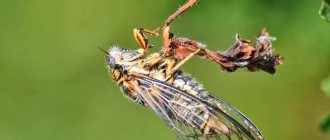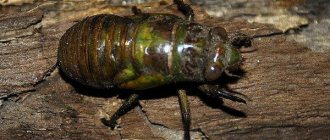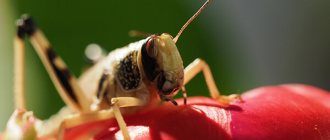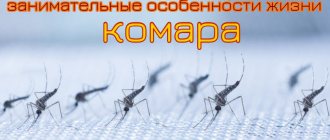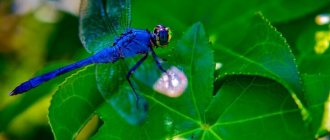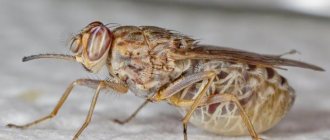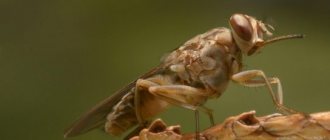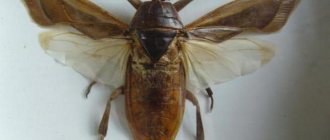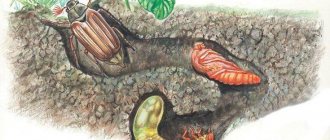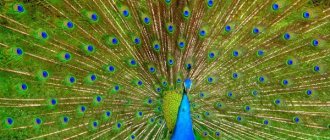These insects have a beautiful name, their chirping is really very melodic. That, perhaps, is all their “service to humanity.” Along with the damage caused by other types of insects, the “activity” of cicadas is an eternal disaster for agriculture.
Every year the industry lacks tons of grain, root crops, melons, and berries. Controlling these pests is very difficult. But information about the features of their life cycle and biological properties allows the use of effective countermeasures.
Description and features
The cicada is an insect belonging to the order Hemiptera. There are up to 2,500 species in nature. Externally, the cicada resembles a large fly. Body sizes of insects vary from 25 to 50 mm, with folded wings slightly larger.
Anyone who has been to regions with a warm climate in the summer has probably heard a loud chirping sound that sounds throughout the day, intensifying in the evening. And if he asked who was making such noise, he already knew that it was a cicada.
Cicada
On a note. The cicada chirps like a grasshopper, but more melodiously and much louder.
In most species of song cicadas, only the males can make sounds. They do this using the vocal apparatus, which looks like a cavity with membranes. The membrane begins to vibrate due to the movement of a special muscle, producing a loud sound. This is how males attract females.
On a note. During the mating season, the volume of insect singing is equal to the noise that an approaching train makes in the subway.
Appearance of the larva
The cicada larva looks like a mole cricket. This creature is 3–5 mm long, milky or light yellow in color. The body is wide, dense, massive head and chest. The forelimbs look like claws. They are thick, powerful, covered with a hard cuticle. With their help, the larva digs long passages in the ground.
With age, the color becomes darker, acquiring a greenish-brown tint.
Appearance of an adult cicada
The cicada's body shape vaguely resembles a grasshopper. Large short head, elongated body tapering towards the end. But the head has two large compound eyes, between them three simple ocelli are located in the shape of a triangle. Oral apparatus – proboscis, short antennae.
The wings of the cicada are transparent, the front ones are much longer than the back ones. 3 pairs of strong legs, of which the hind leg is the longest. The color depends on the species of a particular individual; it can be light green, gray, brown, with a variety of designs and patterns.
Structure of the vocal apparatus
The vocal apparatus has three cavities: two lateral and one median. Inside the median there are two pairs of membranes: folded and shiny, similar to mirrors. The middle cavity serves as a resonator. The side ones open outward thanks to holes, and the eardrum is located on the inner wall. A special muscle is attached to it, the contraction and relaxation of which causes this membrane to vibrate. These vibrations produce a metallic ringing, which, with the help of resonance in the middle cavity, turns into a loud, piercing sound.
Types of cicadas in Russia
There are only 2 species of cicadas living in Russia - common and mountain. You can meet them in the Crimea, Transcaucasia, the Caucasus, and the Mediterranean.
Common cicada
The common cicada is a slightly larger than average-sized insect, growing up to 32–38 mm. The brown-green color allows for excellent camouflage from birds and other insectivorous predators. The transparent wings are very hard and sharp. Adults are active during the daytime. Most often, females lay eggs under the bark of trees.
Mountain cicada
Mountain cicadas are the only species adapted to temperate climates. It can be found even in Siberia. This is one of the smallest species of cicadas; the body size of an adult insect does not exceed 20 mm.
Females lay eggs on the stems and shoots of plants. The hatched larvae first live on the grass, then move into the soil.
Nanotechnology
Psaltoda claripennis is a cicada, the surface of its wings is covered with microscopic spines. This surface kills bacteria that get on the wings. Scientists plan to use the discovery to create bactericidal materials.
Insects are interesting if you look at them carefully. Scientists still have many species of cicadas and other invertebrates to study. Many amazing discoveries have been made in science, and we still have to learn new secrets from the life of insects, their structure and behavior. Many arthropods lead complex lifestyles. Cicadas have an unusual structure and are record holders among insects. Moreover, they are very beautiful. Anyone who has seen the mass emergence of adult song cicadas from the last stage of the larval nymph will clearly not remain indifferent.
Lifestyle and habitat
Cicadas are diurnal insects; they are most active in bright sunlight and sleep at night. This is also due to the fact that heat is an important source of energy that insects need to live. In particular, males require a lot of energy to produce calling calls throughout the day.
Habitat
Cicadas live in large groups and prefer warm, dry climates. They can most often be found in deciduous forests and bushes, less often in fields and steppes. Typically, insects settle on trees and shrubs, preferring the highest branches.
Taxonomy [ edit | edit code]
In 2022, a revision of subfamilies and tribes was carried out, including the identification of 10 new tribes and the restoration of the subfamily Tettigomyiinae.
Cicad >Latreille, 1802
Cicadettinae Buckton, 1889
Tribes: Carinetini Distant, Chlorocystini Distant, Cicadettini Buckton, Dazini Kato, Hem >Latreille, 1802
Tribes: Burbungini Moulds, Cicadini Latreille, Cryptotympanini Handlirsch (=Tacuini Distant), Cyclochilini Distant, Distantadini Orian, Dundubiini Atkinson, F >Distant, 1905 (n. stat., 2018)
Tribes: Lacetasini Molds & Marshall, 2022, Malagasiini Molds & Marshall, 2022, Tettigomyiini Distant, 1905, Ydiellini Boulard, 1973.
Tibicininae Distant, 1905
Tribes: Chilecicadini Sanborn, 2014, Platypediini Kato, 1932, Selymbriini Moulds & Marshall, 2022, Tettigadini Distant, 1905, Tibicinini Distant, 1905.
Shedding
During the period of its stay underground, the larva goes through several molts. The last and most important moult characterizes the transformation of the larva into a mature insect. When the time comes, the larvae begin to move towards the surface of the earth, digging a passage.
Having climbed to the surface, they find the nearest tree and crawl up it. During the movement, the shell bursts and the larva crawls out of it. At this moment, the insect looks like a light, soft creature. But after a few hours, the chitinous shell darkens, hardens, and the insect takes on its usual appearance.
Reproduction, life cycle and lifespan
After mating, the female cicada lays eggs in leaf tissue, under the skin of shoots or the bark of the trunk. After 30–40 days, larvae emerge from the eggs. First, they feed on the sap of the plant, then fall to the ground and burrow to a depth of 1 m. The larva develops underground for several years, after which it climbs to the surface to turn into an adult insect.
An adult cicada lives 3-4 weeks. This time is enough to find a partner and mate, thereby ensuring procreation.
Beetle of history
Biologist Gene Kritsky calls periodical cicadas the bugs of history. A human life is enough to see the appearance of a brood only four or five times, no more. And each time the cicadas return to a completely new world.
When the Great Eastern Brood appeared in 2004, there were no iPhones or YouTube, and the first social networks had only just appeared. Then the cicadas interfered with a golf tournament in Ohio. During a television broadcast, the famous golfer Tiger Woods was distracted and looked in amazement at the trees from which the deafening singing of insects could be heard.
Before 2004, the Great Eastern Brood hatched in 1987. That time, Kritsky had a chance to talk with an elderly woman who had witnessed other appearances of these cicadas. “She told me that in 1936, when she was seven years old, she was playing with her brother,” the biologist said in the Radiolab program. “A cicada landed on his nose, she hit it with a baseball bat and broke his brother’s nose. After 17 years, she showed periodical cicadas to her daughter. And 34 years later I was going to show it to my granddaughter.”
In 1970, The Great Eastern Brood was featured in a Bob Dylan song. He listened to the chirping of cicadas as he received an honorary degree from Princeton University, and then wrote a song about them called “The Day of the Locust.” In 1936, the appearance of the Great Eastern Brood inspired American poet Ogden Nash. Two cicada generations earlier, the New York Times worried about the fate of the Great Eastern Brood. “Around Washington, field after field is being plowed so deep that it could kill the entire brood that was buried in the soil 17 years earlier,” the newspaper wrote in 1902.
English colonists from Plymouth Colony, 1621
Image: Bettmann/Contributor/Getty Images
To early colonists, sudden cicada invasions seemed like a disaster of biblical proportions. “The English had never seen or heard anything like it before or since,” William Bidford, governor of the Plymouth Colony, wrote in 1633. “The Indians told them that diseases would follow the flies.” This happened in June, July and August.”
The fears were in vain. Cicadas are almost harmless: they do not bite or cause damage to crops. Despite this, a wary attitude towards these insects remained until the 19th century. “We are informed that in some places the locusts are found underground in great abundance,” panicked a Maryland newspaper in 1751. “It’s very close to the surface and has grown to almost full size.” May the Lord deliver us from inevitable disaster!”
This month some unusual flies crawled out of the ground; the English call them locusts. When they first appeared, people broke them and ate them, just as John the Baptist is said to have eaten.
Diary of Lutheran priest Andreas Sandel, May 1715, first mention of the Great Eastern Brood
In 1752 and 1749, subsequent appearances of the Great Eastern Brood were observed by the prominent naturalist of the time, John Bartram. Another quarter of a century later, the frequency of the appearance of cicadas was calculated by one of the American founding fathers, Thomas Jefferson. “It seems that they come out of the ground once every 17 years, rising from an extraordinary depth,” he wrote in 1775.
Entomologist Charles Lester Marlatt finally dotted the i’s. In 1898, he divided all American cicadas into 30 broods according to habitat and year of appearance, assigning each its own Roman numeral. Only 15 of them have survived to this day. Brood XXI, which reached Florida, disappeared before Marlatt completed his classification. Connecticut Brood XI has not been seen since 1954 and is also considered extinct. The existence of another 13 has not been confirmed.
Harm from cicadas
Taking into account the fact that both larvae and adults feed on plants, cicadas cause serious damage to agricultural plantings. The list of crops that suffer from pests is very wide:
- grain crops (almost all types);
- legumes;
- vegetables (most varieties grown);
- roots;
- oil plants;
- melons;
- grape;
- garden berries;
- roses.
Nutrition
Adult cicadas suck sap from plant tissues, piercing leaves, shoots, fruits, even tree bark with their proboscis. The larvae damage the root system, basal part, lower leaves, and stems. Pathogenic microorganisms and infectious agents penetrate into the plant through the puncture site. Over time, the plant begins to weaken, the leaves lose color, become deformed, fall off, the fruits become covered with a sticky dark coating, and their taste deteriorates. Cicadas cause the greatest damage to berry crops, yield losses reach 100%.
What kind of food
The insect prefers plant sap. To obtain food, the cicada has an elongated proboscis. It is with this organ that the representative pierces the bark of trees and dense stems. Females also use the ovipositor for this purpose.
A favorite delicacy is juice hardened by exposure to air. Cicadas are garden pests. The butterfly destroys the harvest of grain, berries and root plants. Significant population growth is periodically recorded. When controlling, the life cycle period should be taken into account. Cyclids are food for earthen wasps.
How to fight?
To prevent plant death and crop damage, the fight against cicadas must begin as early as possible. Preventive measures are very important to significantly reduce the risk of pests. To kill insects, it is advisable to use an integrated approach, which will be much more effective.
Safe ways to fight
To prevent the spread of cicadas, you must:
- regularly inspect plants, trim and destroy damaged parts;
- promptly collect plant residues and carrion from the soil, which are then burned;
- after harvesting, dig the soil deeply so that the eggs and larvae are on the surface, in which case they will be eaten by birds or destroyed by frost;
- Place bird feeders, natural enemies of cicadas, near the plantings.
It is recommended to plant onions and garlic between the beds or fruit trees and shrubs. These plants are believed to repel cicadas.
Chemical methods
Chemicals will help effectively get rid of pests. To combat cicadas, the following are most often used:
- Karate 050 EU;
- Fastak.
Both drugs are classified as contact-intestinal insecticides. It is recommended to spray the affected plants twice with a break of 10 days between treatments. According to the manufacturers, after this the insects will disappear.
The drugs must be used in accordance with the instructions, observing safety precautions. The treatment is carried out in calm weather, in the evening. If the dosage is observed, Fastak does not have a negative effect on plants. After spraying Karate 050 EC, the crop can be harvested no earlier than 20 days later.
